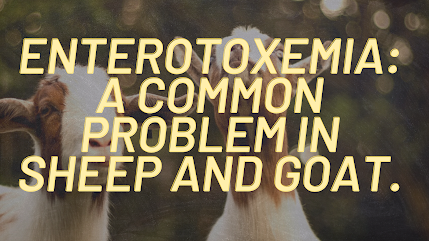ENTEROTOXEMIA
ETIOLOGY
• Caused by clostridium perfringens that produce toxin starting
from A to F of which clostridium type A, B, C, D, E are important.
INTRODUCTION
It is an infectious disease of ruminant which is
caused by clostridum perfringens gram positive bacteria which produce toxin.
It`s mainly effected maximum 2-10 month
of animal.
The bacteria of this disease are found in soil, feaces
and intestine of ruminant.
Excess milk feeding,grasses increase the number of bacteria which produce toxin
that goes in blood and transfer to whole body of animal.
TYPES OF CASUATIVE AGENTS
1. Clostridium perfringens type-A:
eexact role of type A in relation to disease in
cattle,calves and lambs is not clear. It produce toxin.enterotoxaemic jaundice
is seen in sheep and cattle.The affected animal show respiratory distress,
bloody foam from mouth and nostrils.
2. Clostridium perfringens type-B:
The organism
produce a disease known as lamb dysentery. Organism produces α, β and Σ toxin. The β toxin produces enteritis (inflammation of
small intestine) and Σ toxin affect
the neural tissue. The disease is characterised by servere dysentery abdominal
pain, aimless wandering. Peracute case will lead to sudden death without
showing any clinical manifestation.
Small necrotic area, surrounded by zone of haemorrage are
noted in the intestinal mucosa. Liver is enlarged and friable.
3. Clostridium perfringens type-C
It affect sheep, goat, and cattle. It produce hemorrhagic enterotoaxemia which is an acute disease of young calves. It produce both α and β toxin. Excess feeding of milk causing intestinal stasis favour the multiplication of the organism and thereby production of toxin. Clinical sign include abdomin pain, weakness, depression, failure to nurse, hemorrhagic diarrhoea.
The lesions are found in small
intestine particularly in jejunum and ileum characterized by hemorrhagic
changes. There is also necrotic and ulcerative change.
4. Clostridium perfringens type
It is a disease of sheep but cattle and goat are occasionally affected.It produce α toxin. The young sheep and calves are affected. There is diffuse reddening of abomasal mucosa, sub- endocardial and myocardial hemorrhage. The central nervous system(CNS) may be affected. For this, animal may become blind. Sheep may show the sign of glycosuria. Straw coloured fluid is found in the periteneal, pleural and pericardial sac.
In sheep the disease is also
known as pulpy kidney disease. Affected
lamb may jump in the air, fall in ground go in convulsion and die within few
minutes.
The sheep that die suddenly may not show any post mortem
lesions. Haemorrhagic lesions are seen in peritoneum, epicardium, endocardium,
diaphgram, abomasum and duodenum. There is softening of kidney. Kidney change
develop in 3 to 4 hr following death.
5. Clostridium
perfringens type-E:
It produce α and β toxin. There is fatal infection leading to death. There is hemorrhagic changes in the intestine.
6. Clostridium perfringens type-F:
The organism produces potent toxin and causes diarrhoea in calves and lambs. It is not certainly known as to be causative agent of any fatal disease of animal.
Sign and Symptoms;
• Maximum
animal die without showing any symptoms.
• Affected
animal temperature became 107°F.
• Redness of
eye.
• Problem in
breathing.
• Diarrhoea
• Dehydration
• Abdomin
pain
Treatment;
• Penicillin
inj. 10,000 unit per kg body wt or strepto penicillin 5 gram in large animal
and 1-2 gram in small animal twice a day for 3days in intra muscular can be
given.
• Oral and
systematic antibiotic may be tried but treatment does not yeild satisfactory
response.
• Antitoxin
if available can be given soon after birth.
• Vaccination
can be done.

Comments
Post a Comment